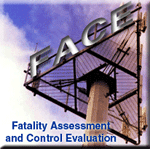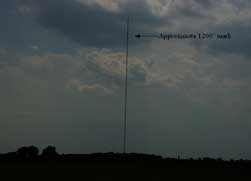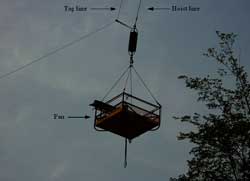NIOSH Fatality Assessment and Control Evaluation (FACE) Program
|
Hispanic Tower Erector Falls to Death from
Television Tower in Nebraska
|
| Nebraska Case Report: 03NE019 |
Report Release Date: January 4, 2005
|
Summary (top)
A 22-year-old Hispanic male tower technician fell 1200 feet to his death from a 1500 foot high television transmission tower. The victim was part of a five person maintenance crew reinforcing the tower after installation of a high-definition television antenna. While changing positions, the victim, who was using a positioning system but not an independent fall protection system, slipped and fell. The victim was pronounced dead at the scene. 
The Nebraska Workforce Development, Department of Labor’s Investigator concluded that to help prevent future similar occurrences, employers should:
-
Ensure employees are tied off 100% of the time.
-
Ensure employees wear appropriate work clothing at all times.
-
Ensure personal protective equipment (PPE) is suitable for the task being performed and maintained in a safe condition.
-
Retrain those employees that have not retained the requisite understanding and/or skills necessary to protect themselves and others during climbing operations.
Program Objective (top)
The goal of the Fatality Assessment and Control Evaluation (FACE) workplace investigation is to prevent future work-related deaths or injuries, by a study of the working environment, the worker, the task the worker was performing, the tools the worker was using, and the role of management in controlling how these factors interact.
This report is generated and distributed solely for the purpose of providing current, relevant education to employers, their employees and the community on methods to prevent occupational fatalities and injuries.
Introduction (top)
On June 16, 2003, at approximately 4:30 p.m., a 22-year-old Hispanic male tower technician died after falling 1200 feet from a television transmission tower. The Nebraska Department of Labor was notified of the fatality the same day by the Occupational Safety and Health Administration (OSHA). The Nebraska FACE Investigator met with the investigating OSHA Compliance Officer (COSHA), company officials and local law enforcement authorities on June 17, 2003, at the mishap location. This was the State’s fourth tower-related fatality in the last 14 months involving workers upgrading structures for high-definition television transmission.
The victim’s employer is a tower erection/repair company (SIC 1799/NAICS 23599). The company has been in business since 1986. At the time of the incident the company employed approximately 50 employees at multiple locations throughout the United States. The company had a written safety and health program which was provided to the COSHA. The employer is a member of the National Association of Tower Erectors (NATE) and one of four companies that wrote the initial NATE guidelines for tower erection safety. Prior to this incident they had entered into a partnership agreement with OSHA’s Region 5 to promote safety during tower activities and facilitate a better working relationship between private industry and OSHA.
The employer had a previous history of fall fatalities prior to this incident. Also, five months after this incident, the company was performing similar work on a television tower in Alabama when the tower collapsed, killing three more employees.
Investigation (top)
Victim: The victim was a 22-year-old Hispanic male. The tower company had employed him since January of 2000 as a tower technician. According to company officials he was the most experienced worker on site with 3 ½ years of tower climbing experience. He had been on this site for two weeks.
Training: Each new tower technician undergoes five days of intensive tower safety training at the company headquarters. Copies of the training program and victim’s training records were provided to the COSHA.
Equipment: A personal fall protection system is comprised of an anchorage point, a full body safety harness with a shock absorbing lanyard, and a body positioning system. The lanyard is connected to an anchorage point at one end, and to the back D ring on the safety harness on the other end. Should a fall occur, the lanyard would “deploy”, dissipating a substantial amount of the fall’s energy, limiting the energy imposed on the employee.
A body positioning system is normally comprised of a lanyard with a single hook at each end. It is connected to the body harness’s front D ring, wrapped around a structural member, then hooked back into the body harness front D ring. This allows the worker to be supported at an elevated work location and work with both hands free.
The victim’s fall protection system consisted of a DBI SALA full body harness, model #1108652, that was manufactured in March of 2002 with a single-leg lanyard with “pelican” hook attached to the back ‘D’ ring.
His positioning system was a 1” x 6’ Centurion adjustable web lanyard hooked to the ‘D’ ring with a Symons ( pelican style) hook attached at the end. Company officials stated that the victim had been issued a new front hook three days prior to the incident.
Worker 2 (tower technician): Employed by the company for 1 ½ years and had been on site approximately one month.
Worker 3 (tower technician): Employed by the company for 8-9 months and had been on site approximately four weeks.
Worker 4 (hoist operator): Employed by the company since January of 2001 with a six month break, returning to work November 2002. He was the on-site hoist operator.
Worker 5: Employment history was unknown.
Analysis/Synopsis (top)
The victim’s company started tower reinforcement construction at this site in October of 2002. The job consisted of an overall structural upgrade on the tower by replacing bent metal bracing, mounting a digital antenna on the side of a tower leg, and reinforcing the antenna legs using “half pipe” bracing. They sub-contracted another company to install the antenna, which was accomplished between January and March of 2003. The present crew came to the site in April of 2003.
The victim’s crew had been working on the 1500 foot high tower for several weeks, with three more days of work left before the project was completed.
On the day of the incident, the victim and workers 2 & 3 checked each other’s safety harnesses to ensure they were correctly hooked. A pre-lift meeting was conducted with all on-site company employees in attendance.
To access the tower structure the victim and workers 2 & 3 used a “pan” ( suspended personnel platform). The pan is raised and lowered by a hoist specifically rated to lift personnel. A tag line is secured above the pan to prevent the employees and pan from contacting the tower during hoisting. Pre-lift hoist testing had been conducted every two weeks by the site supervisor or when necessary, and all test results were documented.
The workers climbed into the pan with their tools, hooked their lanyards to the pan and began their ascent. Workers 4 & 5 were controlling the hoists. At the 1200 foot level the workers had to disconnect from the pan and reconnect to the tower. Workers #4 & 5 went inside the transmitter building to begin operating the tower’s elevator to move parts and equipment up to the workers. Communication was maintained between all five employees via walkie-talkies.
The victim was working on the South leg (face) of the tower tightening bolts on the half-pipe support braces. Worker #2 was working on the east side of the South leg. Worker #3 was assisting both the victim and worker #2, and was also carrying parts from the pan to the tower.
Worker #3 was assisting the victim by holding a piece of half-pipe bracing so the victim could install bolts. He stated that he did see the victim’s short front positioning lanyard wrapped around the “hog rod” (horizontal structural brace) and hooked back into the front ‘D’ ring. He also stated that the harness’s rear lanyard Pelican hook was not secured to the tower’s structure, but secured to the harness’s rear “D” ring. Worker #2 also saw the victim at this same time and stated that the victim was tied off to the tower leg using his front positioning lanyard and appeared to have his leg wrapped around the tower structure.
Worker #3 stepped back into the pan to get more bolts. As he turned back towards the victim, he heard him say an expletive and saw him falling straight down. Worker #2 also heard a noise, looked up and saw the victim falling. The victim struck a radome and ice shield during the fall.
Worker #3 radioed worker #4 that the victim had fallen. Worker #4 notified worker #5, who then used the transmitter building’s phone to call 911. Rescue personnel from a nearby town responded. The victim was declared dead at the scene.
During the employee interviews and on-site investigation, three significant factors were noted:
Factor 1. The pelican hook on the victim’s front lanyard was found to be defective during post-incident investigation. The tip of the hook was off-set approximately 2 ¼” from the latching device. Several other hooks of the same type were inspected in the equipment trailer. All were misaligned between the tip of the hook and the latching mechanism, but not to this excessive degree.
The COSHA sent the victim’s harness and lanyard assembly to an OSHA lab for analysis. Portions of the report are paraphrased as follows:
The hook is designed for a load up to 5000 pounds on a straight pull. However, this hook is only required to withstand a 350 pound load for 1 minute for a side load on the latching mechanism. (ANSI 2359.1 and CSA 259.1)
A calculation of the equivalent impact force from a height of 5 feet (the length of the lanyard), a nominal 200 pound man, a deceleration through 2 inches (the deflection seen in the hook) given a force of 6000 pounds. If the lanyard gives an additional 3 inches of stretch for a total of 5 inches, the force is 2400 pounds. The formula used is Force = (weight in pounds) x (fall distance in feet)/(deceleration distance in feet). This force is seen to easily exceed the design criteria when the hook is subjected to a side load.
A side load will be generated when the hook is placed such that it cannot take the force in a vertical manner according to its design criteria. A close examination of the tower configuration would need to be made to determine if attachment to a diagonal member or other structural member could result in a side deflection.
The only actual failure evident was the bending of the hook. Further damage was noted on the gate guard. While the existence of other hooks bent due to side loading suggests a common link, given the nature of the accident and the observable damage to the hook, it cannot be ruled out that the damage occurred during the fall. There is no readily apparent impact damage to the hook in a location other than that observed on the guard.
Factor 2. Footwear: the victim was working on the tower structure wearing only white calf-length cotton socks on his feet and no shoes at the time of his fall.
Factor 3. Fall protection system: the victim did not have his fall protection system tied off to an anchor point at the time of his fall.
There are two possible scenarios for this incident:
-
As the victim attempted to change positions, he disconnected his front positioning lanyard and stood up to move. As he did so, his feet slipped off of the horizontal member he was standing on causing him to fall.
-
As the victim attempted to change positions, he slipped, falling straight down. Side loaded pressure was applied to the Pelican hook’s latching mechanism, causing it to “roll out” of his front ‘D’ ring.
Cause of Death (top)
According to the death certificate, the cause of death was: Massive head injury.
Recommendations/Discussion (top)
Recommendation #1: Ensure employees are tied off 100% of the time.
Discussion: Statements taken from workers #2 & #3, along with pictures taken at the incident site, showed that the back lanyard pelican hook was hooked into the victim’s back ‘D’ ring at the time of the fall. Training records showed that the victim had been trained in proper tie-off procedures during initial training, and it was constantly reinforced during safety meetings. Workers #2 & #3 said that they always “got on each other” if one of them forgot to tie off properly. Although worker #3 saw the victim did not have his back lanyard secured he did not mention it to the victim. Constant vigilance by both workers and managers is needed to ensure compliance with the best safety practice of 100% fall protection. A work positioning device system (front lanyard) is just that, a positioning device, not part of the fall protection system.
Consideration should be given to replacing the single-leg rear lanyards with a twin-leg lanyard. This would require a climber to first unhook one of the rear attaching devices and re-connect it before unhooking the second rear attaching device. This would allow a climber to be constantly tied off with the fall arrest system while switching positions.
Recommendation #2: Ensure employees wear appropriate work clothing at all times.
Discussion: The victim was not wearing shoes at the time of his fall, only white cotton socks. It could not be determined whether his shoes were in the pan or had been left on the ground before the ascent. 1Basic equipment for climbing towers generally consists of a hard hat, short leather gloves, leather climbing boots with good arch support, a standard positioning belt and an approved safety harness with lanyards.
Recommendation #3: Ensure personal protective equipment (PPE) is suitable for the task being performed and maintained in a safe condition.
Discussion: 2Snaphooks shall be sized to be compatible with the member to which they are connected to prevent unintentional disengagement of the snaphook by depression of the snaphook keeper by the connected member, or shall be a locking type snaphook designed and used to prevent disengagement of the snaphook by the contact of the snaphook keeper by the connected member.
This style of Symon’s pelican hook was originally designed to fit into concrete forms. Due to its’ large inner gap area it is widely used in the tower industry along with a lanyard as a positioning device. This hook was never designed to be wrapped around a supporting member and then hooked back into a ‘D’ ring, due to the possibility that a “load” could be placed on the latching mechanism, causing it to fail and allow the hook to “roll out” of the ‘D’ ring.
Several Symon’s pelican hooks that were inspected in the company’s on-site equipment trailer also showed that they had been exposed to a side load, causing the tip of the hook to be offset from the latching mechanism.
3It is the responsibility of each employee to check their PPE on a daily basis, or each time they wear it for signs of wear, damage and other deterioration and defective components. Any equipment that is faulty must be removed from service and either repaired, replaced and/or destroyed.
Recommendation #4: Retrain those employees that have not retained the requisite understanding and/or skills necessary to protect themselves and others during climbing operations.
Discussion: 4When the employer has reason to believe that any affected employee who has already been trained in fall protection does not have the understanding and skill required by previous training, the employer shall retrain each employee. Worker #2 stated that although he saw the victim was not tied off to the tower structure, he failed to say anything about it.
References (top)
-
Guidelines for the Radio, Television, and Communications Tower Industry, Accident Prevention Safety and Health Program, National Association of Tower Erectors, second edition, revised September 17, 1997.
-
OSHA Part 1926 Code of Federal Regulations for Construction Standards, 1926.502(d)(5) & (e)(7).
-
OSHA Part 1926 Code of Federal Regulations for Construction Standards, 1926.502(d)(21) & (e)(9).
-
OSHA Part 1926 Code of Federal Regulations for Construction Standards, 1926.503(c).
Two additional resource documents available are:
-
NIOSH ALERT, Preventing Injuries and Deaths from Falls during Construction and Maintenance of Telecommunication Towers, Publication No. 2001-156.
-
OSHA INSTRUCTION, Interim Inspection Procedures During Communication Tower Construction Activities, Directive Number CPL 2-1.29.
Attachments (top)
|
|
Site Diagram (not to scale)
|
 |
 |
|
TV tower looking southwest showing approximate location where victim fell from.
|
Pan used to hoist employees onto tower. Note tag and hoist line attachments.
|
|
|
|
Victim’s pelican hook showing 2” offset gap between hook tip
and latching mechanism.
|
|
|
|
|
Two examples of other pelican hooks being used by employees showing the offset between the hook tips and the latching mechanisms.
|
To contact Minnesota State FACE program personnel regarding State-based FACE reports, please use information listed on the Contact Sheet on the NIOSH FACE web site Please contact In-house FACE program personnelregarding In-house FACE reports and to gain assistance when State-FACE program personnel cannot be reached.
|